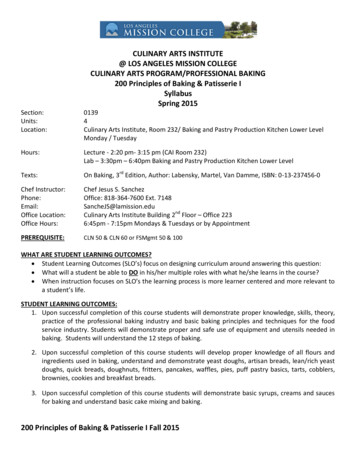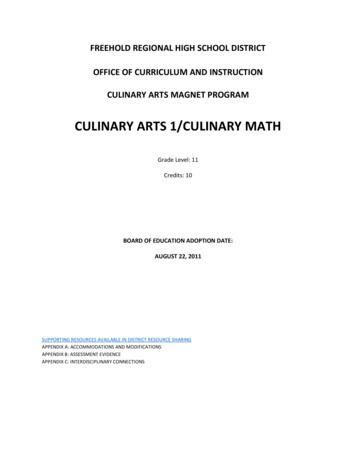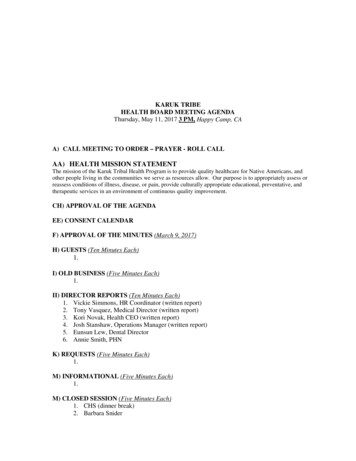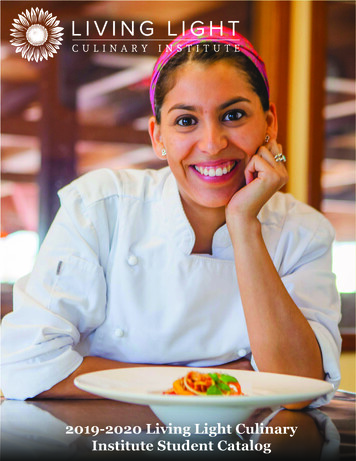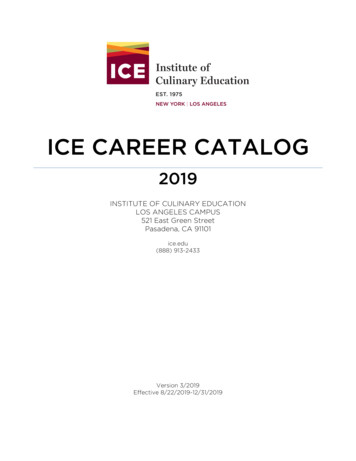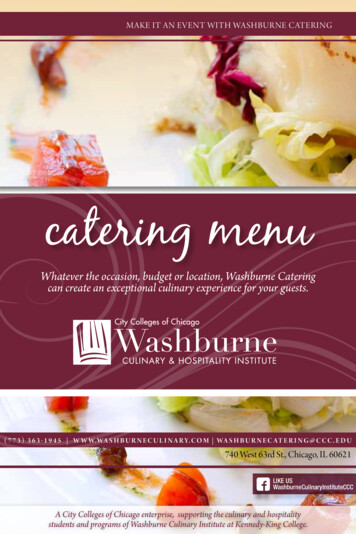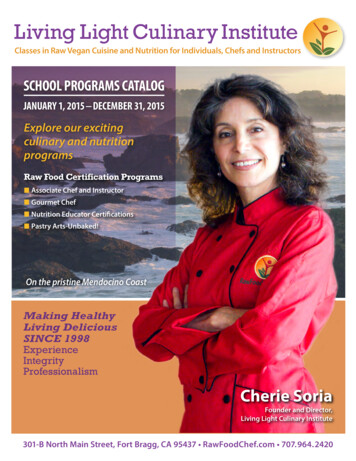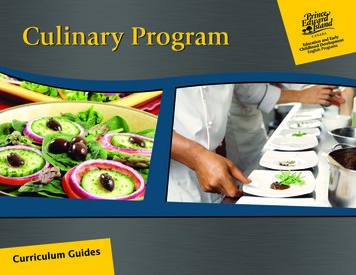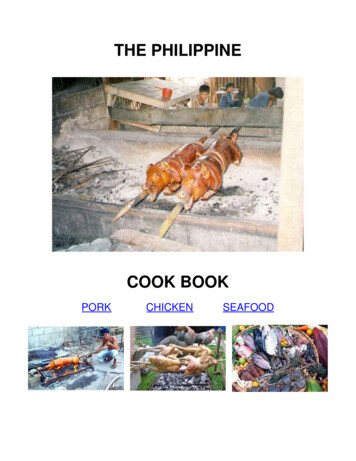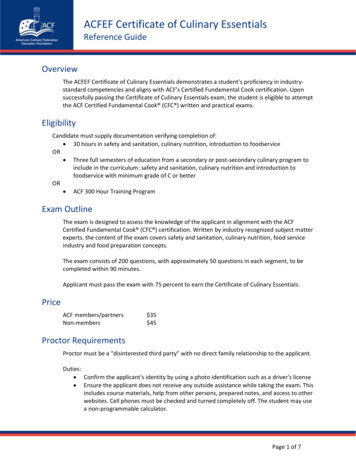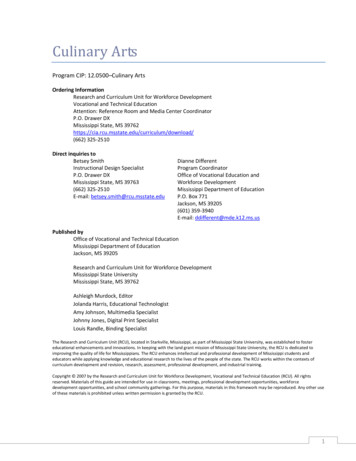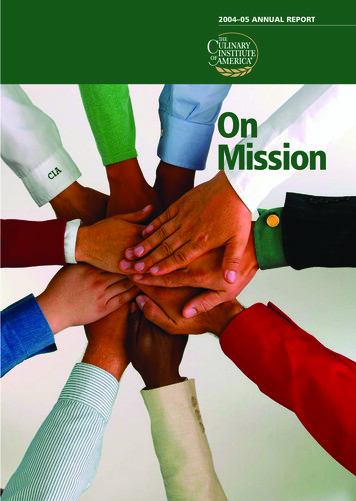
Transcription
2004–05 ANNUAL REPORTOnMission
2OUR MISSIONMessage from the Chairmanand the President3The Culinary Institute of America is a private, not-for-On Mission: To Learn5profit college dedicated to providing the world’s bestOn Mission: To Live11professional culinary education. Excellence, leadership,On Mission: To Lead17professionalism, ethics, and respect for diversity are theFinancial Highlights22core values that guide our efforts. We teach our stu-Board of Trustees26In Memoriam29The Society of Fellows30Our BenefactorsHonor RollBoard of TrusteesFellowsCorporations and FoundationsAlumniParentsFriendsGifts-in-KindThe Society of the MillenniumGifts in MemoriamGifts in rshipsExpendable ScholarshipsEndowed Scholarship Funds (ESFs)Named Facilities at the CIA48485053The Culinary Institute of America 2005dents the general knowledge and specific skills necessary to live successful lives and to grow into positions ofinfluence and leadership in their chosen profession.This annual report, covering Fiscal Year June 1, 2004 through May31, 2005, was submitted at the Annual Meeting of the Corporationof The Culinary Institute of America on October 29, 2005. 2005 The Culinary Institute of AmericaPhotography: Roger Ball, Bill Dennison, Peter Finger, Eric Futran,A. Blake Gardner III, Terrence McCarthy, Al Nowak, Lorna Smith,and Paul TalleyThe Culinary Institute of America, 1946 Campus Drive, HydePark, NY 12538-1499 845-452-9600 www.ciachef.eduThe CIA at Greystone is a branch of the CIA, Hyde Park, NY.
MESSAGE FROMTHE PRESIDENTAND CHAIRMAN“The Changing Landscape.”We’ve all heard it before, this oft-usedmetaphor suggesting growth, advancement,and, yes, change: the changing landscapeof computing the changing landscape ofpolitics even the changing landscape ofeducation. Such progress and innovation areever-present at The Culinary Institute of America, and in the past year, “changing landscape”has adopted an increasingly significant—andquite literal—meaning on both of our campuses.When the finishing touches are put on ourHyde Park campus master plan, visitors will beamazed at the transformation. The campus hasalways been beautiful, from the very first days ofconverting this former Jesuit seminary into aneducational institution to the more recent additions of a library, recreation and sports facility,and center for Italian cooking. But never beforehas this property undergone such a spectacularfacelift all at once, starting with the constructionof four new student lodges on the north end ofcampus and continuing with Anton Plaza, theAdmissions building, various parking lot andlandscaping projects (including new athleticfields), and, ultimately, additional lodges.At our Greystone campus, two extraordinarynew facilities, the Ventura Center for MenuResearch and Development and the WilliamsCenter for Flavor Discovery, draw culinary professionals to our Napa Valley campus toexplore the complexities of food and wine.What drives all of these activities, and keeps ussteadfast in the face of change as we move forward into an exciting and promising future?Our mission. Every physical enhancement wemake, every new curriculum concept we conceive, every dollar we spend, is all done in support of the college mission.This past year, The Culinary Institute of America did much to strengthen its leadership position not only in culinary education, butthroughout the food industry. On the pagesthat follow, you’ll read about some of theefforts, initiatives, and people who have playedkey roles in the changing landscape of theworld’s premier culinary college. We thank allof you—benefactors, Fellows of the Institute,and Trustees—for helping us remain, as always,on mission.DR. TIM RYAN, C.M.C.PresidentNICK VALENTIChairman of the BoardThe Culinary Institute of America 20053
4The Culinary Institute of America 2005
The CIA is a private, not-for-profitcollege dedicated to providing the world’sbest professional culinary education. TO LEARNA rich history of educating aspiring culinarians an accomplished group of alumni who are leading the industry recognition this year as “the best cooking school in America” by themost widely read magazine in the U.S., Reader’s Digest. For TheCulinary Institute of America, it doesn’t get any better than this.Or does it?This past year, the CIA’s education team has taken steps tomake sure we continue to excel as we stay on mission to providethe world’s best professional culinary education.So the CIA’s faculty and administrators have been busy learning—about teaching practices in the kitchens, bakeshops, andclassrooms; about how effectively we assess students beforemoving them forward in the curriculum; about ways we can usetechnology to enhance the learning experience; and about howwe can prepare our students for evolving industry demands.“Who dares to teach must never cease to learn.”John Cotton Dana, famed American librarian and museum directorInnovative curriculum, topnotch instruction, and outstanding facilities help keep uson mission to provide theworld’s best culinary education.The Culinary Institute of America 20055
ONE OF 13 U.S. MASTER PASTRY CHEFSFRANK VOLLKOMMERCIA Lecturing Instructor in Baking andlocation approved by the A.C.F. toPastry Arts Frank Vollkommer, C.M.P.C.,hold the Certified Master Chef andC.H.E., became one of just 13 CertifiedCertified Master Pastry Chef exams.Master Pastry Chefs in the United StatesChef Vollkommer joins the eight Certi-by completing the demanding 10-dayfied Master Chefs on The Culinary’s fac-exam administered by the Americanulty and staff that give the college moreCulinary Federation at the college’ssuch Masters than any other educa-Hyde Park campus. The CIA is the onlytional institution or corporation.ENHANCING THE LEARNING EXPERIENCETO LEARN INNOVATIONThe college charged a special CurriculumInnovation Committee to review and, wherenecessary, realign the core curricula. Aftermany hours of studying the strengths andweaknesses of the Progressive Learning Yearsystem, as well as the bachelor’s degree courseof study, the committee is developing educational models that will underscore our reputation as a leader, and further differentiate usfrom any other culinary college.TO LEARN STUDENT NEEDSThe CIA’s Middle States accreditation has elevated the college to a new level as an institutionof higher education, a level at which there aregreater demands to assess what students areactually learning. The Culinary has respondedto those demands with proactive and comprehensive programs exploring the areas of studentassessment and information literacy.The CIA assigned a committee to examinewhat our students are learning, how we assesstheir coursework, and what level of expectationis placed on students in terms of informationliteracy. The latter topic involves providing students with the skills to explore issues not onlyby asking the right questions, but by knowinghow and where to find the answers to reachconclusions with knowledge and integrity.6The Culinary Institute of America 2005What has been the result so far? The education team has established baseline data forassessing students and their abilities, giving thecollege valuable information to effectivelymatch learning objectives to student needs,and to strengthen the learning assessmentprocess.TO LEARN TECHNOLOGY APPLICATIONSOne of the most exciting educational enhancements of the past year has been the implementation of IntraLearn —a Web portal that steersstudents toward taking more responsibility fortheir education. Students can view an entirecourse guide online, access their course schedules, and view some of the course materials.IntraLearn also gives instructors the ability topost links and readings, and integrate the technology into the actual classroom experience asa teaching tool. For example, if a student has aquestion about fermentation in a HearthBreads and Rolls class, the instructor can usethe system to link to a presentation by a leading authority in fermentation.
The CIA’s education team continues to find new and creative waysto give students the best possible learning experience.The Culinary Institute of America 20057
SERVING THE INDUSTRYTO LEARN INDUSTRY NEEDSWhat’s the best way to get new curriculuminsights that better align CIA teaching withindustry needs? Go right to the industry itself,as the CIA has done by instituting a new seriesof events on campus—the Society of FellowsAdvisory Roundtables. By participating inthese roundtables, Fellows of the Institute notonly take an active role in the college’s educational process, they provide a valuable conduitto the industry in a focused format, giving theCIA tremendous insight into what industryleaders are seeking in a student. The first tworoundtables, “Manufacturing” and “On-SiteCatering,” were held in the spring. Additionalroundtables on the schedule include “Restaurants” and “Hotels/Resorts/Clubs/CruiseLines.” The feedback from industry experts atthese roundtables will ultimately have a significant impact on the CIA curriculum.TO LEARN FOODSERVICE SOLUTIONSThe Culinary found more ways than ever toserve the professional development andresearch needs of the foodservice industry. Adynamic new division of the college, theIndustry Solutions Group, offers custom training to the industry in developing fields such ashealth and wellness, supplier and operator relations, flavor exploration, research and development, and training and certification. TheIndustry Solutions Group combines theresources of the college’s Hyde Park campuswith the cutting-edge programs based at theCIA at Greystone, which are supported by twoextraordinary new facilities, the Ventura Center for Menu Research and Development andthe Williams Center for Flavor Discovery.The Culinary also added a third level to itsProChef Certification program for culinaryprofessionals and continued to grow its Professional Wine Studies courses, online MenuMasters Program for Menu Research andDevelopment, and food enthusiast offerings.Additionally, the college teamed with foodindustry leaders to launch the ProfessionalChef Discovery Series, a selection of tuition-8The Culinary Institute of America 2005free E-learning courses designed to teach culinary professionals new ideas about ingredients,cooking techniques, and the recipe trends thatare leading contemporary cuisine.TO LEARN BY EXPERIENCEOur faculty members continue to distinguishthemselves not only through their teachingskills, but also by their accomplishments outside the classroom. Lecturing Instructor FrankVollkommer passed the Certified Master PastryChef examination administered by the American Culinary Federation and, more recently,Associate Professor Olivier Andreini sawmonths of intense preparation culminate in hisbecoming an A.C.F.-Certified Master Chef. Thechair of professional wine studies at The Culinary Institute of America at Greystone, KarenMacNeil, was named “2005 Educator of theYear” by the European Wine Council and wona Washington-area Emmy for her PBS series“Wine, Food & Friends.” And a team of CIAfaculty and staff was invited to prepare dinnerfor the prestigious Ivy Awards banquet.The recognition and honors these and manyother CIA instructors have earned enhance thecredentials of the college’s faculty as a wholeand continue to add value to the CIA degree.The Williams Center for Flavor Discovery at Greystone helps support the college’svaried and ever-expanding industry solutions programs.
BRINGING CIA EXPERTISE TO INDUSTRYISGHow can leading companies best reach the forefront of newdisciplines affecting the foodservice industry? The IndustrySolutions Group, a new division at the CIA, offers customtraining to organizations that want to leverage the CIA’sexpertise, especially in a number of key emerging areas ofinterest. Clients identify and achieve their goals by workingwith a single Industry Solutions Group senior consultant.This creates long-term relationships in which the CIA canprovide curriculum development, ideation services, prototype development, and, ultimately, customized solutions.Yes, it does get “better than this,”and it takes a broad range of initiatives to makeit happen. To provide the world’s best professional culinary education, the entire CIA community—faculty, staff, students, and our friendsin the industry—helps keep us on mission.The Culinary Institute of America 20059
10The Culinary Institute of America 2005
Excellence, leadership, professionalism, ethics,and respect for diversity are the core valuesthat guide our efforts. TO LIVEThe Culinary Institute of America is, above all, an educational institution.But with a diverse faculty and student body, a vibrant campus environment, and a variety of athletic and recreation choices, the CIA is an idealplace for living as well as learning.This past year, the main campus has undergone an extensive transformation—perhaps more so than at any other time since the college moved toHyde Park. Enrollment initiatives, new student activities, enhanced hiringpractices, and expanded facilities all create an atmosphere that encourages everyone to live by the college’s core values. For it’s not only thework we do, but the values by which we live that keep us on mission.“Character is higher than Intellect. A greatSoul will be strong to live as well as think.”Ralph Waldo Emerson, American writer, philosopher, poet, and essayistTO LIVE AND FEEL AT HOMEFrom a comprehensive library to a fully equipped recreation center to aspectacular center for Italian cooking, the CIA has long been committedto providing the very best facilities for living and learning. This past yearbuilt strongly on that heritage, as execution of the campus master planmoved full speed ahead.Four Adirondack-style lodges were built to ease the housing crunch oncampus and give students an opportunity to enjoy a full campus lifeexperience. The co-ed lodges—named Cinnamon, Nutmeg, Juniper, andClove—offer housing for 280 additional students. Designed with the inputof CIA students, each lodge was built with a large kitchen equipped withthree five-burner stoves, full-size refrigerators, cooking island, prep area,and dining area. These shared cooking and lounge areas help build astrong sense of community among students.Studying in the library, diningwith friends, relaxing in thepool—it’s all part of thewell-rounded living experience students get at the CIA.The Culinary Institute of America 200511
AN ENRICHING ENVIRONMENTThanks to the new lodges, more students thanever before are living on the Hyde Park campus—80% of the entire population, a 20%increase from the prior year.Construction was also well underway on AntonPlaza, which will provide a beautiful landscaped terrace overlooking the Hudson Riverfor students to gather, and the Admissions Center, which will feature an attractive, professionalfacility to welcome students to campus as wellas a large theater for cooking demonstrations.On the West Coast, the CIA at Greystone addedmore housing options for its certificate programstudents. The newly renovated, CIA-owned Marlinda Center on Pratt Avenue is located approximately 11 2 miles from the college’s Napa Valleycampus, with regularly scheduled shuttle serviceto and from Greystone.TO LIVE WITH MUTUAL RESPECTThe CIA made a concerted effort to ensure acomfortable environment for everyone wholives, learns, and visits here. The college established a Diversity Council to further embraceawareness of diversity and inclusiveness in thecampus culture. The CIA held campus-widediversity training, and also distributed a diversity survey to faculty and staff. One highlightof the survey: 85% of respondents said working with individuals from diverse backgroundshelps increase the creativity and uniqueness ofthe organization.The CIA also continued its dedication torecruiting and retaining a diverse faculty. Tohelp maintain and motivate a world-class staff,the college’s Human Resources Departmentdeveloped “Premier Performance,” a compensation plan and performance management systemthat assures that individual employee performance is linked to the CIA’s mission and goals.College Admissions targeted its recruitmentefforts to create a diverse and highly qualifiedstudent body. To help achieve that objective,they attended large college fairs in urbanareas; ran programs such as “All Aboard CIA,”which brings New York City high school students to our Hyde Park campus via the train;networked with national student organizations;and reached out to diverse schools with strongculinary and baking and pastry arts programs.Effective communications helped increaseawareness of the CIA to ensure a larger poolof high-quality students. The college garnered708.4 million branded media impressionsaround the world, a 16% increase from the previous year. Web-based marketing initiativesincluded new value-added online newsletters,distribution of 1.5 million e-mails, and anenhanced Web site that allows users to personalize their online CIA experience according totheir interests.The beautiful grounds of our Hyde Park campus give students idealopportunities to relax and reinvigorate themselves outside thekitchens and classrooms.12The Culinary Institute of America 2005
MAKING THE CIA A BETTER PLACE TO LIVETHE ANTONS“Standing here looking out over theto their involvement. Thanks to thebeautiful Hudson Valley, we areAntons, students will have a spectacularreminded of our first visit to the CIA.open space for studying, socializing, andFrom that moment on, we knew thisrelaxing on campus.was a school with which we wanted toMr. Anton is vice chairman of thebe become involved.” Those were theCIA’s Board of Trustees andwords of William Anton two years ago,founder/chairman of Anton Airfood,at the groundbreaking of a new facilityInc. Mrs. Anton is the company’s presi-for which he and his wife Patricia pro-dent and chief executive officer, as wellvided most of the funding. Today,as a CIA Fellow of the Institute.Anton Plaza stands as a lasting tributeTO LIVE AND BE INSPIREDWe like to make campus life as much like “home” to students as possible,and every good home opens its doors to visitors. The college continuedto expand and enhance its various lecture series and special events tobring to campus industry guests who inspire students not only by theircareer accomplishments, but by the leadership and professionalism theyhave shown.In addition to the food industry leaders who address our graduates ascommencement speakers every three weeks, a number of lecture series oncampus gave students an opportunity to learn from different experiencesand perspectives on a variety of subjects, both culinary and otherwise.The Dooley Lecture Series brought noted authors and media professionals to the CIA to discuss subjects as diverse as politics (Scott Ritter,author, End Game: Solving the Iraq Problem), economics (Vanessa Summers, author, The Girls’ Guide to Money and Investing), and, of course,food (Laura Shapiro, author, Something From the Oven). The Food andBeverage Operations Lecture Series featured a number of respectedindustry professionals such as CIA alumni Brian Averna ’81 and StephenLoffredo ’83, Trustee Charles Merinoff II, and President Tim Ryan. TheZagat Lecture Series on Hospitality welcomed distinguished presenterssuch as Le Cirque Director Sirio Maccioni to the CIA to speak with students. And the Sharing Knowledge Series recently brought HaroldMcGee, author of On Food and Cooking: The Science and Lore of theKitchen, to campus.The CIA’s diverse lecture series have broughtmany respected food industry professionals tocampus, including Harold McGee (top), BrianAverna ’81 (middle), and Sirio Maccioni (above).The Culinary Institute of America 200513
JUST FOR THE FUN OF ITTO LIVE WELLAs always, the CIA was a fun place to be thispast year. From the Stars & Stripes Weekend tothe Halloween Bash to the Winter FormalDance, there was alw
college dedicated to providing the world’s best professional culinary education. Innovative curriculum, top-notch instruction, and out-standing facilities help keep us on mission to provide the world’s best culinary education. “Who dares to teach must never cease to learn.” John
